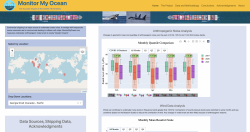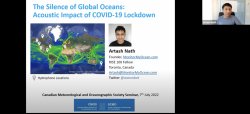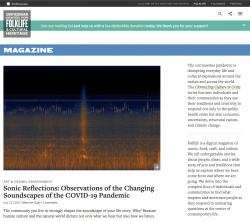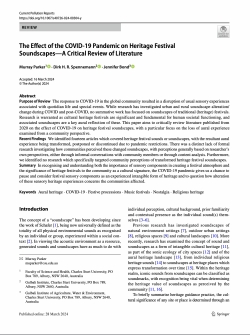Monitor My Ocean: The Acoustic Impact of the COVID-19 Pandemic

Type
Other
Authors
Nath ( Artash Nath )
Category
Website
[ Browse Items ]
Publication Year
2021
URL
[ private ]
Tags
Abstract
COVID-19 Lockdowns: A human tragedy and a research opportunity to study anthropogenic impact on our environment
The COVID-19 virus was first identified in December 2019. Since then the world changed. It led to the closing of national borders, lockdowns, travel restrictions, economic slowdowns, and changing how people lived their lives. The pandemic was a human tragedy. It was also a rare research opportunity to measure the effects of the global "anthropause" on our environment.
On Land: Measuring changes in seismic vibrations during COVID-19 lockdowns
The pandemic closed my school doors in 2020 and 2021 and the schooling became virtual. I used this opportunity to apply my scientific, big data, and technology skills for public good. I started measuring the effectiveness of COVID-19 lockdowns by analysing changes in seismic vibrations in Canadian cities using open data from the Canadian Seismic Stations Network run by Natural Resources Canada. I was able to calculate how effective the lockdowns were in reducing human movements in 10 Canadian cities through my web application: http://www.MonitorMyLockdown.com .
In Global Oceans: Measuring changes in underwater anthropogenic noise levels
Yearly increases in global trade - 80% of which occurs through ocean routes means that underwater noise levels in global oceans are rising. Unfortunately, the low-frequency noise from propellers and machinery of 60,000 container ships and ocean tankers overlap with frequencies marine mammals such as whales, dolphins, and orcas use to communicate and navigate. It leads to stress and increasing collision with ships. The COVID-19 pandemic led to a drop in marine traffic in waters of over 70% of countries because of the economic slowdown, reduced exports, and cancellation of ocean tourism season. An opportunity presented to measure the changes in underwater anthropogenic noise levels in global oceans using data from hydrophones (or underwater microphones) run by ocean observatories in the US, Canada, New Zealand Spain.
A model was developed to standardize the measurement of anthropogenic noise levels. Twenty years of cumulative hydrophone data from seven oceanic regions were analyzed. Fast-Fourier transformations, power spectral densities, long-term spectral averages, and quantile analysis were undertaken to extract noise of anthropogenic origin. The noise levels during the lockdown period were compared with previous and subsequent years at different third-octave bands (63 Hz, 125 Hz, and 1 kHz) to calculate the impact of anthropogenic activities such as commercial shipping, tourism, and offshore energy exploration. The results have been presented as an interactive web application: https://www.MonitorMyOcean.com
The COVID-19 virus was first identified in December 2019. Since then the world changed. It led to the closing of national borders, lockdowns, travel restrictions, economic slowdowns, and changing how people lived their lives. The pandemic was a human tragedy. It was also a rare research opportunity to measure the effects of the global "anthropause" on our environment.
On Land: Measuring changes in seismic vibrations during COVID-19 lockdowns
The pandemic closed my school doors in 2020 and 2021 and the schooling became virtual. I used this opportunity to apply my scientific, big data, and technology skills for public good. I started measuring the effectiveness of COVID-19 lockdowns by analysing changes in seismic vibrations in Canadian cities using open data from the Canadian Seismic Stations Network run by Natural Resources Canada. I was able to calculate how effective the lockdowns were in reducing human movements in 10 Canadian cities through my web application: http://www.MonitorMyLockdown.com .
In Global Oceans: Measuring changes in underwater anthropogenic noise levels
Yearly increases in global trade - 80% of which occurs through ocean routes means that underwater noise levels in global oceans are rising. Unfortunately, the low-frequency noise from propellers and machinery of 60,000 container ships and ocean tankers overlap with frequencies marine mammals such as whales, dolphins, and orcas use to communicate and navigate. It leads to stress and increasing collision with ships. The COVID-19 pandemic led to a drop in marine traffic in waters of over 70% of countries because of the economic slowdown, reduced exports, and cancellation of ocean tourism season. An opportunity presented to measure the changes in underwater anthropogenic noise levels in global oceans using data from hydrophones (or underwater microphones) run by ocean observatories in the US, Canada, New Zealand Spain.
A model was developed to standardize the measurement of anthropogenic noise levels. Twenty years of cumulative hydrophone data from seven oceanic regions were analyzed. Fast-Fourier transformations, power spectral densities, long-term spectral averages, and quantile analysis were undertaken to extract noise of anthropogenic origin. The noise levels during the lockdown period were compared with previous and subsequent years at different third-octave bands (63 Hz, 125 Hz, and 1 kHz) to calculate the impact of anthropogenic activities such as commercial shipping, tourism, and offshore energy exploration. The results have been presented as an interactive web application: https://www.MonitorMyOcean.com
Description
https://www.monitormyocean.com/
Number of Copies
1
| Library | Accession No | Call No | Copy No | Edition | Location | Availability |
|---|---|---|---|---|---|---|
| Main | 612 | 1 | Yes |



